Darkness is the absence of Light . . .
So in the sudden shadows which fog the minds of men and women
. . . into the unknown.”
Dark Venture (1945-47) aired “The Cover Up” on February 25, 1947. This is only the fourth show we have run of what was billed as a “psychological thriller,” the first being in 2018 and the last being in January of 2020. Aside from the fact that there were 130 or so episodes of which a mere dozen survive, there is so much mis-information, innacurate information, and conflicting information among many online old time radio websites (some reportedly reputable and authoritative), that I turned to long-time friend of this show and Golden Age of Radio historian Karl Schadow for help. Karl wrote the liner notes for the Radio Spirits CD collection of Dark Venture (pictured above left), and with his kind permission–-and my thanks–-I will excerpt from his far more in-depth introduction, wherein he details the history of this under-appreciated radio show.
“Dark Venture premiered on June 5, 1945, enjoying a continuous run through December of 1947. During this thirty-one month period, all of the episodes were produced and broadcast from various facilities of station KECA, ABC’s Hollywood affliate. The cast was an interesting mix of performers. Not only were elite actresses Jeanne Bates, Betty Moran and Lurene Tuttle featured in the series, but opportunities were also bestowed upon radio newcomers Daphne Drake and Martha Shaw. The men’s roles were often given to stalwarts Charles Lung, Earl Ross and Bill Johnstone. Stage and screen stars occasionally appeared on the program as well, resulting in impressive individual performances by William Tracy and Carl Harbord.
“For the frst ten months, Dark Venture was a regional feature, limited to broadcast on ABC’s Pacifc Coast network, which consisted of fifteen stations in five states. After commencing on Wednesday’s at 9 pm, the program moved to Tuesdays in July of 1946. It is currently unknown why ABC did not initially route the program to the entire nation. However, on February 19, 1946, it did achieve full network coverage. Two months into this series, the New York Times (April 7,1946) published Larry Marcus’ compliment to the wisdom of his audience, who demanded scripts that would have to involve “believable characters and natural situations out of which will spring movement and suspense…to tell an honest story of emotional upheaval.”
…
“On April 16th, 1946, Dark Venture entered the commercial ranks. The Wildroot Company, through its long-time advertising agency Batten, Barton, Durstine &Osborn, signed on as sponsor to promote its Cream-Oil Hair Tonic through April 8, 1947.”
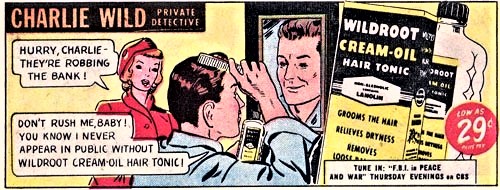
…
“Past aired episodes of Dark Venture (from 1946) were adapted for use by the Armed Forces Radio Service (AFRS) and broadcast without Wildroot’s promotional copy. The program was one of many to be featured on the AFRS Mystery Playhouse. Hunter Galloway was this series’ narrator.”
And finally, “During the initial West Coast run of Dark Venture, the Hollywood-based Radio Life (January 27, 1946) acknowledged that the series “offers realistic psychological studies of men and women with troubled minds who choose the hard way, the fast way, the wrong way to solve their problems.” Once the program garnered a coast-to-coast audience, many newspaper editors expressed opinions similar to those of Mike Mann of Knickerbocker News, Albany, New York. He called the show “one of radio’s standout dramas…a psychological thriller with plenty of action.” Walter Winchell championed Dark Venture in his daily syndicated column (April 14, 1946), declaring it to be “gifted with fine word weaving–-a rarity among radio dramas.”
“The Cover Up” is set in Germany during World War II. It is the desperate tale of a woman chasing the man who murdered her fiance shortly before they were to be married. It is a time when one’s true identity is kept close to the vest for there are certain Germans employed to do nothing but hunt down and kill certain marked individuals. Their own identities are heavily guarded, including one known only as a “Nazi werewolf.” As the woman travels as secretly as she can from one location to another and by various modes of transportation in her search for this Nazi werewolf, the story becomes more closely aligned to that of a spy vs. spy thriller, the paranoia escalating to a fever pitch until the unexpected denouement is revealed. Aside from the audio being a tad less than optimum, this is a fine example of the fare to be found in Dark Venture and I recommend it.
Play Time: 27:10
{“The Cover Up” aired on a Tuesday evening, so it was inevitable that the neighborhood gang would head for the corner newsstand after school the next day to empty their pockets of the nickels and dimes that had been burning holes in their pockets for more than a week. Science fiction was the order of the day this visit and they were in for a treat. Astounding SF (1930-present, now Analog) was a gimme and its purchase was a foregone conclusion. It was a monthly in 1947. Startling Stories (1939-55) was also a favorite with its free-swinging adventure stories and colorful, page-turning action. The issue below was no exception as it featured a new story by “world wrecker” and “galaxy smasher” by early and very popular pulp writer Edmond Hamilton. Startling Stories was a bi-monthly in 1947. Thrilling Wonder Stories (1936-55), within general parameters, published much the same kind of exotic adventure fare as did Startling Stories, and with just as many popular writers of the day as SS, witness cover stories on the issue below by none other than Henry Kuttner and Murray Leinster. The neighborhood gang hit the jackpot with this visit to the newsstand. TWS was also a bi-monthly in 1947.]
[Left: Astounding, Feb. 1947 – Center: Startling Stories, Jan. 1947 – Right: Thrilling Wonder Stories, Feb. 1947]
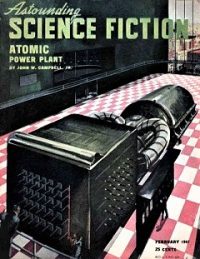

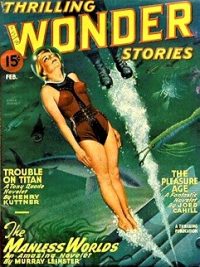
To view the entire list of weekly Old Time Radio episodes at Tangent Online, click here.
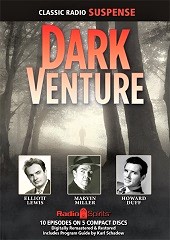
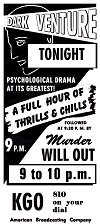 “Over the minds of mortal men come many shadows. . .
“Over the minds of mortal men come many shadows. . .